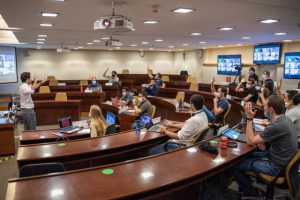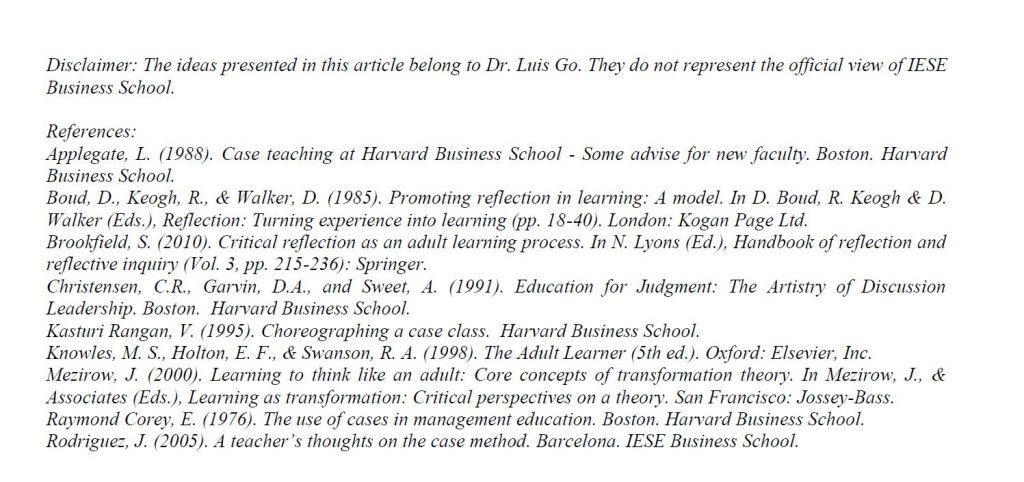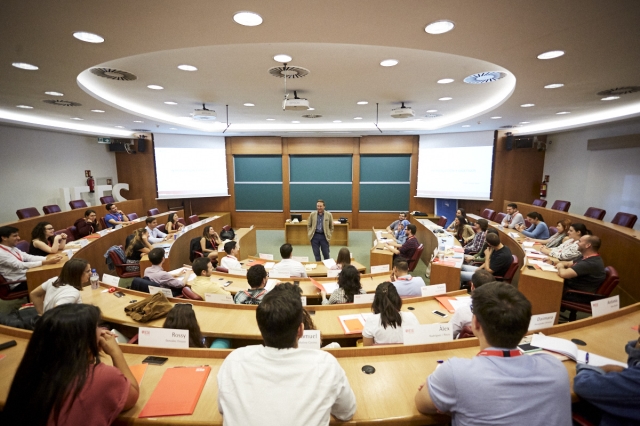IESE is well known for its strength in the case method style of teaching, how is it different as compared to other business schools? In this post, Dr. Luis Go from our MBA & MiM Admissions Team shares some research on what the case class is all about and his opinion on what makes the IESE case method distinctive.
The meaning of ‘Harvard-style’ case class
The ‘Harvard-style’ case class is distinguished by two aspects: the quantity of cases and the mode of delivery of the case classes. Quantity pertains to the amount of business cases used in the program. In my opinion, ‘Harvard-style’ means that the great majority of the classes in the program are delivered through cases. At IESE, it’s around 80%. Numerically, that’s 400 plus cases. Typically, the ‘Harvard-style’ delivery of case classes refers to the use of the ‘choreographing’ case class. Below is a more thorough explanation.
Distinct types of case class and the ‘orchestrating case class’
Pedagogically, there are four distinct types of case class. These are illustrating case class, theorizing case class, lecturing case class and choreographing case class (Kasturi Rangan, 1995). The first three could be categorized as teacher-centered approach, while the last one could be classified as student-centered approach.
Here, I want to go into a brief discussion on terminologies. The term ‘orchestrating’ is, in my opinion, more appropriate than ‘choreographing’. After all, the bull pit classroom setting resembles more a musical ensemble rather than a dance formation. And the case class professor, rather than a choreographer, resembles more closely a conductor of an orchestra who directs while the students through their class participation produce the music. In this article, ‘orchestrating’ will replace the term ‘choreographing’.
In the first three types: illustrating, theorizing, lecturing, the professors tend to have greater control over the progression of the class and the flow of the discussion. To deliver the contents, professors can follow a set agenda that require minimal participation from the students. The students tend to be passive recipients. The composition or the diversity of the students has little impact on their learning because these types of case class usually have the minimal interaction between learners.
On the other hand, the essence of ‘orchestrating’ case classes is the high levels of involvement from the students in class. Learning occurs through their active participation.
“Perhaps the greatest pedagogical benefit of the case method is that it generates a high degree of involvement in the learning process. People learn the most from those things in which they are most deeply involved … The effective use of cases as a learning vehicle depends heavily on class participation” (Raymond Corey, 1976).
Educational theories often advocate active learning over passive learning. Research shows that the more the students are actively involved in the learning process; the better and the more profound and enduring are their learning. (Boud et al., 1985; Brookfield, 2010; Knowles et al., 1998; Mezirow, 2000).
“…through the interchange and constructive controversy [in ‘orchestrating’ case classes] the students build analytical skills, develop judgment and gain conceptual understanding. It also promotes rigorous thinking and develops communication skills” (Raymond Corey, 1976).
 The ‘orchestrating’ case class is a powerful way of learning for business students. It is also more demanding on the professors. The case class professors are required not only a mastery of the case, the theories behind it, and the learning points of the case, but more importantly, during the case class itself, they need to be much more engaged, highly attentive to the myriads of unanticipated responses from the students and be able to ‘think on their feet’. With heavy and active participation of the students in the case discussion, the flow of the class becomes more unpredictable. The professor has to be flexible and be ready to adjust the lesson to allow for the integration of spontaneous inputs and ideas from the students. While directing the flow of the discussion to the learning points, the discussion professor stays alert ready to recognize unexpected insights that emerge from the discussions (Rodriguez, 2005). He or she attempts to create and maintain a peer-learning environment that capitalizes on the intelligence of the students and the diversity of business cultures and management experiences (Applegate, 1988).
The ‘orchestrating’ case class is a powerful way of learning for business students. It is also more demanding on the professors. The case class professors are required not only a mastery of the case, the theories behind it, and the learning points of the case, but more importantly, during the case class itself, they need to be much more engaged, highly attentive to the myriads of unanticipated responses from the students and be able to ‘think on their feet’. With heavy and active participation of the students in the case discussion, the flow of the class becomes more unpredictable. The professor has to be flexible and be ready to adjust the lesson to allow for the integration of spontaneous inputs and ideas from the students. While directing the flow of the discussion to the learning points, the discussion professor stays alert ready to recognize unexpected insights that emerge from the discussions (Rodriguez, 2005). He or she attempts to create and maintain a peer-learning environment that capitalizes on the intelligence of the students and the diversity of business cultures and management experiences (Applegate, 1988).
“The classroom encounter consumes a great deal of energy; simultaneous attention to process [the flow of activities that make up a discussion] and content [the material discussed] requires emotional as well as intellectual engagement … The discussion teacher is planner, host, moderator, devil’s advocate, fellow-student, and judge – a potentially confusing set of roles. Even the most seasoned group leader must be content with uncertainty, because discussion teaching is the art of managing spontaneity” (Christensen, 1991).
Around 80% of the program delivered through the ‘orchestrating’ case class
MBA programs differ not only in the type of case class used, but also in the level of utilization of the case study method.
The ‘orchestrating’ case class is not the only method of imparting management education; today, we also have simulations, modeling, coaching and projects. Its superiority over traditional lectures is difficult to refute, because case studies looks at business problems not in isolation, but always in relation to all the other components, the different aspects of the business, and more importantly the context of the business problems. It is practically the experience of solving real business problems.
To have close to 80% of the program delivered through the ‘orchestrating’ case class would require a significant number of professors with mastery of the methodology. Hence, very few institutions are able to achieve such high levels. A long-term commitment from the institutions to invest into the development of expertise in this methodology among the teaching staff is necessary. An institutional orientation to provide students with the best preparation possible and an unwavering belief that this is an effective way to help students learn business management, equip them with sound decision making skills, and prepare them for long-term global business leadership are essential.

Global perspectives of students enhanced through intensive peer-to-peer learning at the team level and in the classroom
Of the four types of case classes, the ‘orchestrating’ case class is the one that harnesses and optimizes the diversity of business experiences, academic knowledge, cultural perspectives and creative insights of the students in learning process. The interactive process fosters the formation of a truly global and general management mindset in the students. The high levels of engagement among the students in the case discussion, naturally pulls in their cultural and experiential insights into the learning process.
The other three types, where students tend to be in a relatively passive mode, have to depend more on the knowledge and the lecturing skills of the professor. And in such learning environments, it is no surprise that it is easier for students to be disengaged.
To conclude, based on the definition above I believe the IESE MBA is the one and only European MBA program that employs the ‘Harvard-style’ case class. It is an essential feature that sets the IESE MBA apart. It is a defining quality difficult to replicate as it requires large and continuous investment and an unwavering commitment from the institution. The ‘Harvard-style orchestrating’ case class at IESE is a powerful, transformative and enduring pedagogical method in management education.

To find out more about what students think of the case method at IESE, you can check out this video. If you would like to get a taste of the case discussion with one of IESE’s world class faculty, you can register for one of our upcoming Virtual Open Days on our Events page. See you there!
Pursue your dream MBA! Take these next steps today:







